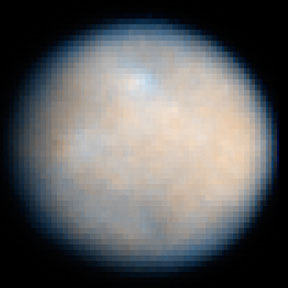
CERES PRESENTATION DONE ON THURSDAY 21 APRIL

(Sorry about the size of the picture I couldn't figure out how to make it smaller.)
Discovery:
Ceres was the first thing to be discovered in the asteroid belt. Sicilian astronomer Father Giuseppe Piazzi first saw this dwarf planet in 1801. When more objects were discovered in the same area they were called asteroids or minor planets. Ceres was first called a planet but was then renamed as an asteroid. In recognition of its planet like aspects it was designated a dwarf planet in 2006 along with Pluto and Eris.
(Ceres' Symbol above)
Ceres is described by scientist as the embryonic planet. Gravitational perturbations from Jupiter eons ago prevented it from becoming a normal sized planet. Ceres ended up among the debris left over from planetary formation in the asteroid belt between Mars and Jupiter. The Hubble Space Telescope observed the planet and it demonstrated and orbit that suggests it has a nearly round body. Its diameter is larger at the equator than at the poles. This planet is around the size of
Composition:
Ceres does not have the same composition as the rest of its neighbors. It I made up of three layers the first being its dusty outer layer than the water ice inner layer and finally the stone core. Astronomers believe that there is water within Ceres because the density of the planet is less than that of the Earth’s crust. Another reason is that the surface of Ceres shows evidence of water bearing minerals.
 Ceres' composition
Ceres' composition
The numbers:
Orbit size
Metric: 413,690,250 km
Scientific Notation: 4.1369025 x 108 km (2.7653485 x 100 A.U.)
Metric: 380,951,528 km
Scientific Notation: 3.80952 x 108 km (2.547 x 100 A.U.)
Metric: 446,428,973 km
Scientific Notation: 4.46429 x 108 km (2.984 x 100 A.U.)
Metric: 947,000,000,000,000,000,000 kg
Scientific Notation: 9.47 x 1020 kg
Metric: 2.09 g/cm3
Surface area
Metric: 2,849,631 km2
Scientific Notation: 2.8496 x 106 km2
Length of Day
0.378 Earth days
9.07417 hours
4.6 Earth years
0.079138251
10.59
Links to Moodle
Hi Calvin,
ReplyDeleteThis is a good post! You definitely have all the data you need in there! I like your pictures and that you captioned them, and I also liked all the data you inlcuded. For the data, however, you used no bold words or colons to showo when you are talking about a specific subject, you just started writing on a new line which made it very confusing. You also have no emotion whatsoever in your post, which makes it very boring to read. I like your explaination about the orbit eccentricity and the orbit inclination, though! You also could have used more color (unless you had trouble doing that). You are also missing "scribe post" as one of your labels. Other than that, this pots is very informative! Keep it up! :)
Hi Calvin I liked your post. I think you organized well. I liked the fact of the data at the end and the history at the beginning. The font that describe your picture it is unreadable. You could add one more links, not only moodle. I had a hard time to read it because the font was a bit too small. I liked that you used only the color black. You had enough since, which was good but the data was too much. I think you got a great improvement from last year. Overall good job. :)
ReplyDeleteCalvin - you turned this post in on time. You have included some great pictures and I am happy you tried to caption them correctly. You also have covered all of the information from the presentation, but I am not sure why you included all of the numbers again - this list makes the post ramble on and not really hook the reader. You have included the link to Moodle, but have not made it 8th grade specific, nor have you linked to your notes, as was required. Plus, you needed to include another interesting link or two that gave new or more information about this particular dwarf planet. Your grammar and punctuation look great, but there are a few spelling errors throughout the writing. Nice work including the date in the title, but your labels are 2/3 correct. Overall, this is a good try, but next time I think you could include more media and more information that would spice up the post. Plus, you should have reviewed the rubric to see what I was grading. ~Ms. D.
ReplyDeleteHey Calvin- This is a good post in many ways. You had pictures and some of them were captioned. Also there weren't any spelling/grammar mistakes so good job there. Also, you have included a hyperlink to Moodle which was good, but I recommend that you link it to 8th grade Science instead of the Moodle homepage. You also had a date in the title which is what many people lack in their posts, and you had correct labels, but one needs to be added saying "4th Quarter". On the other hand, the post was dreary because you lacked multiple colors which makes it easier for the reader to read.I agree with Viktor that this post has no emotion or personality. Also, you had scientific information, but WAY too much in too little space. For instance, all those statistics and numbers. This post could have been better if you also added a youtube video or a link to a game like Ms. D suggested. So overall, this post was okay, but you should fix it up before the final blogging grade, it needs some improvement. I think you could've made this post good like previous posts by simply taking more time. Better luck next time, Calvin.
ReplyDeleteBen